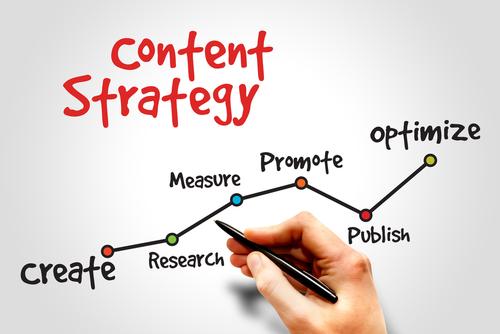Last updated on October 13th, 2022
In order to be effective, a content strategy should have relevant information about the campaign, like the end goals, the target audience, the short-term goals and the key performance indicators (KPIs). However to be both useful and effective, it must also be documented. Not just drawn on the whiteboards of a brainstorm, or drafted on a company mail-trail or an ongoing conversation on a Slack thread. It just cannot be a rough draft.
Instead, you should create a well-written, documented content strategy. Make it official and then circulate it amongst the required stakeholders. Though this seems simple to accomplish, according to the content marketing statistics by the Content Marketing Institute, only35% of content marketers have a documented content marketing strategy.
Why is it important to document a content strategy?
Documenting your content strategy will give you three major benefits –
1. Successful campaigns resulting in better ROI: The content marketers who have a non-documented strategy, 32% of them saw that their results were positive. On the other hand, 60% of marketers who had a documented content strategy saw that their results were positive.
2. Building a winning game plan: Officially documenting the campaign strategy forces your team to come together and think through the aim of the campaign, build the plan through which this aim will come to life, carry out the mental due diligence to make sure that the plan is effective and finally to make the plan actionable by developing it from a strategic level to an executional level.
A well documented content strategy can serve as a map in a way that a rough draft, or mail thread or conversation cannot. It can be used as guidance during times of doubt, as a feedback or learning mechanism, as a basis for the creation of content, or even as a base in the event of starting afresh.
3. An increased marketing budget: A well documented content strategy can be used to justify a higher budget, as ultimately, there are many more benefits to documenting content strategy as compared to not doing it. The next section deals with the aspects of content strategy that should be documented
How to document your content strategy?
Source: Moneygossips
The following seven key elements should be documented as a part of your content strategy:
1) The Mission Statement
The cornerstone of any marketing campaign is its raison d’etre. Before getting into the process of developing content or even thinking about what content to build, the first question that needs to be answered is“What’s the real reason we’re investing in content and what aim to we seek to accomplish by developing this content?” And if the answer is anything close to “Well, we just know that we should be doing content,” stop right there and spend time thinking about why you’re actually making this critical and valuable investment in the first place.
If you have a well-thought-out answer and this is in consensus with all relevant stakeholders, then write it down. Generally the mission statement should answer one of the following questions:
- Are you building content to generate leads and our attract new customers?
- Are you trying to build brand awareness and credibility?
- Are you trying to accomplish a certain goal?
Once you have figured out your reason for investing in content, it needs to take a prominent place. That is in the form of a clear and concise mission statement which appears at the beginning of your strategy; this overall statement will guide the rest of your document and keep you on track when it’s time to execute
2) The Target Audience
Many mission statements include an element about the target audience, but more often that not, that’s not the case. Understanding the target audience is equally important as the mission statement, and hence this next section is dedicated to that. Before building content or developing distribution plans, you need to know who you are aiming to reach through your content. Unless you are creating content for the general public, you’re creating it to reach a specific set or sets of individuals, by which your mission statement can be achieved. So, to build this section you need to include the following:
- Classification of target audience with respect to demographics, socio-economic and cultural factors
- Building detailed and specific target audience personas
- How to reach this target audience
3) The Content Mix
Only once you are sure of your target audience – how to influence and reach them – then only can you determine what types of content to create for them. Different types of content can be used for this purpose and this section outlines that, and also the proportions to which they should be used.
After building the mission and the target audience personas, this step outlines the content mix so that the right amounts of the required content is created. A good analogy for this section would be a recipe. Depending on your campaign and what your sales/marketing funnel looks like, you will need various types of content:
- Content that brings awareness to target audience at the top of the funnel –
- Content that engages or hooks prospects at middle of the funnel and encourages them to take action
- Content for the bottom of the funnel that is very specific and designed to strongly influence action
Now, each of these content types can take any number of forms, from blogs to research papers, from sophisticated sales materials to print ads. So, this section details the amount of each type of content you need to accomplish your mission as well as the different content types that can be used in each category.
Follow the latest content marketing trends to see which kind of content is the hottest. Finally, you can conclude this section by classifying the different content types you will need as – owned, work-in-progress or need to build or purchase.
4) Content Creation Process
The three steps above are all planning steps and you could follow them to the letter, and still not be able to build relevant content. That is why, this step is critical – it ensures that your execution process is well defined so that effective content can be created efficiently. Creating content and turning your company leaders into brand advocates takes time and effort. Before building content make the following are defined:
- Processes, workflows and resources that are most necessary for your team
- Availability of content creation tools
- Media / Agency partners that help in building content
- Robust feedback mechanism – both internal and external to the company
- Your content marketing resources.
- Your use of AI in content marketing
5) A Content Calendar
This element is mainly about making sure you are as efficient as possible. Once you know the different types of content for the three categories of the target audience (mentioned in element 3), it is time to develop a schedule or calendar to make sure that you deliver.
Developing a content calendar goes a long way in converting intent to action, and helps you maintain consistency in messaging. Consistency is absolutely critical in content marketing. A content marketing calendar is an opportunity to build trust with your audience, nurture them, and encourage them to become brand advocates for you as well. A content calendar focuses mainly on two things:
- How often do you need to publish to keep your audience engaged
- Mapping your development to publishing
6) A Distribution Plan
Distribution is making sure that your content reaches the right people at the right time. Having a detailed distribution plan makes sure that this is done in the most cost and time-effective way possible.
Distribution channels can encompass publishing articles in publications your target audience reads or paying for featured ads on social media or even ads attached to emails. In order for your content distribution strategy to be effective, make sure you think through the following:
- Multiple mechanisms to reach your target audience – you want to match your most relevant content with the most effective distribution channel
- Best time to reach the audience to influence them – for e.g. For the working professional, a social media ad makes sense at night/in the evening – when they are more likely to access social media networks
7) An ROI Calculator
A plan is incomplete unless it includes details on how to measure it’s efficacy. This element maps with the mission statement, thus bringing your content strategy full circle. In order to determine whether the execution of your plan is a success or not, you need to first define how you are going to measure success. This could be in the form of qualitative milestones such as reach, engagement levels, traffic to site, leads generated, sales and opportunities created or could even be qualitative in nature.
Once you have defined your metrics for success, the next step is then to make sure that you are able to track these metrics. This tracking capability can be built in-house or can be outsourced, for there are many robust and flexible software packages that can help you track performance. Along with this tracking, you can also map it to costs incurred in developing the content. This way you will have a real time analysis of benefit vs cost.
Additional techniques to document content strategy
1. Mapping content to the customer’s journey
After building the target audience personas, it is important to understand the decision matrix or decision making process for this target audience. As mentioned earlier, the content required at the top of the funnel is very different from the content required at the bottom of the marketing funnel. The funnel you have is a generic model – however most customers will have a decision matrix that is similar yet different. Hence, it is quite helpful to build test case personas with the different decision matrices that could be used while distributing content
2. Using Mad Libs for these target audience personas
Another way to enhance this process is by using persona Mad Libs. They are a great way to ideate on the specific topics that you can address in your various campaigns. They promote creativity and ensure that you truly put yourself in the customer’s shoes. This forces your team to understand the customer’s perspective
3. Miscellaneous tools Depending on the campaign, customer, and content, your strategy could also include:
- Assessment of existing content and it’s returns from the customer
- Assessment of competitors’ content
- Description of the content gap that your campaign addresses
- Budget
- Analysis of useable SEO information
Though documenting content strategy may seem daunting at first, it is well worth the investment, as you set yourself up for success. With these seven elements and three additional tools to achive content marketing goals and detailed as a part of your document, your team will have an unrivaled start.











